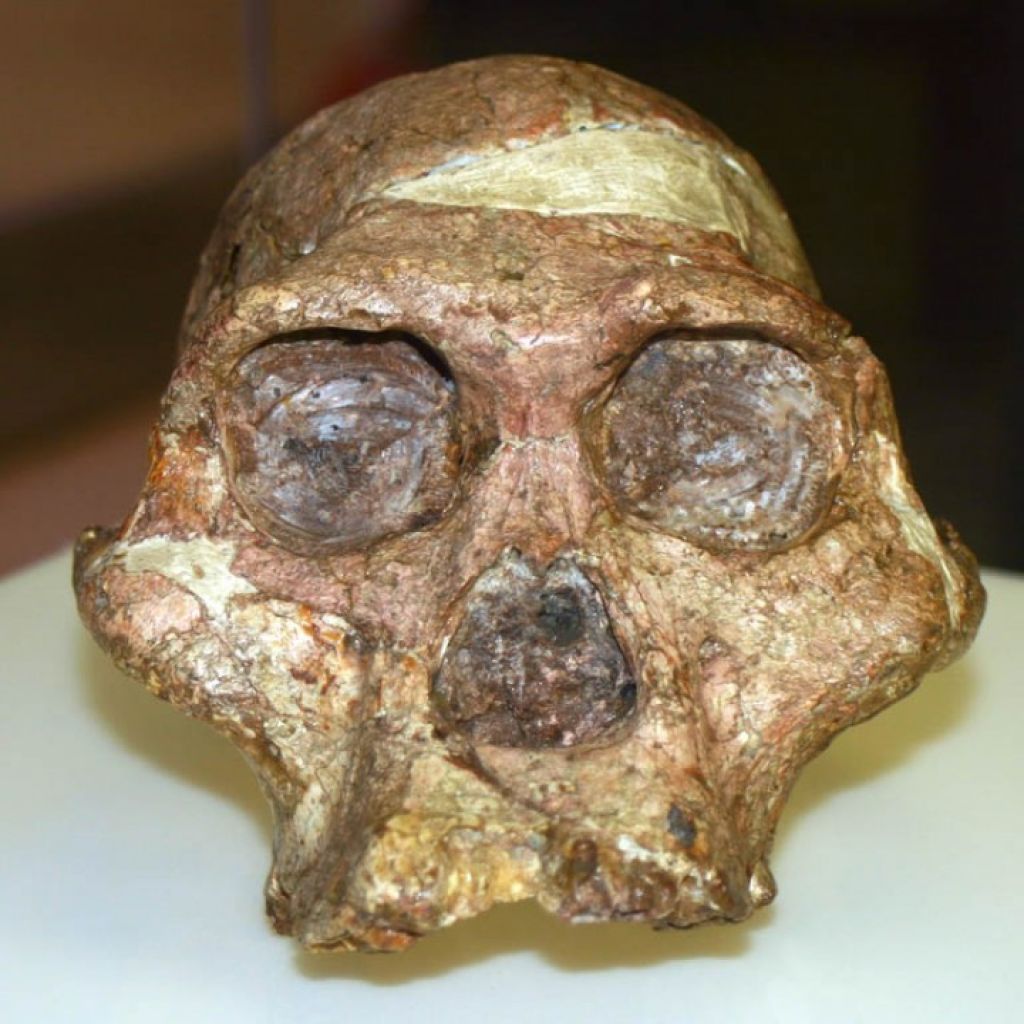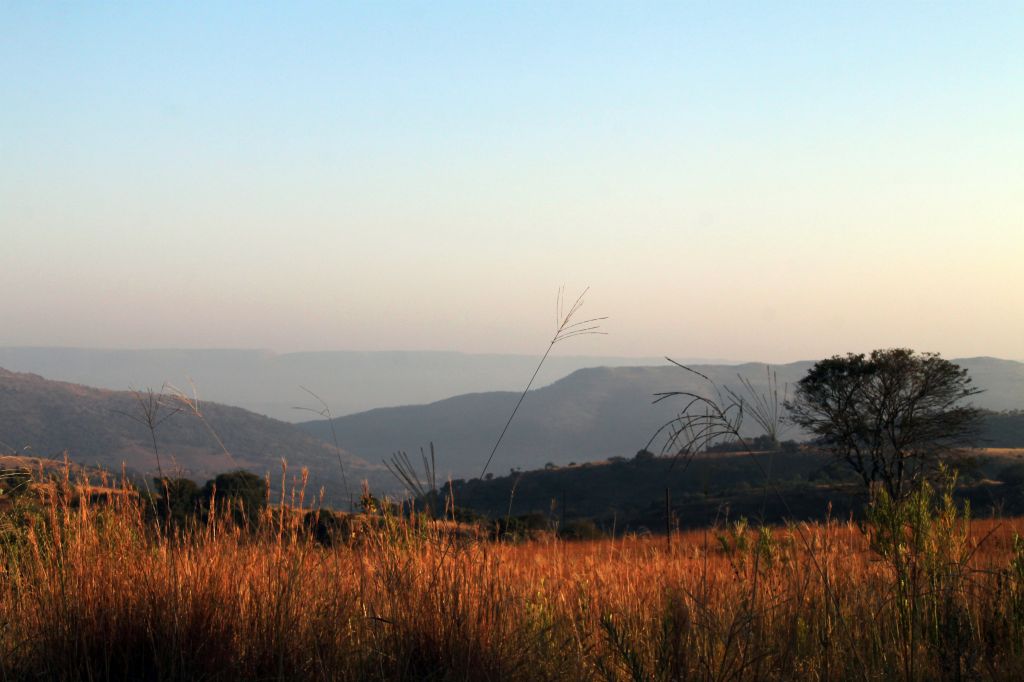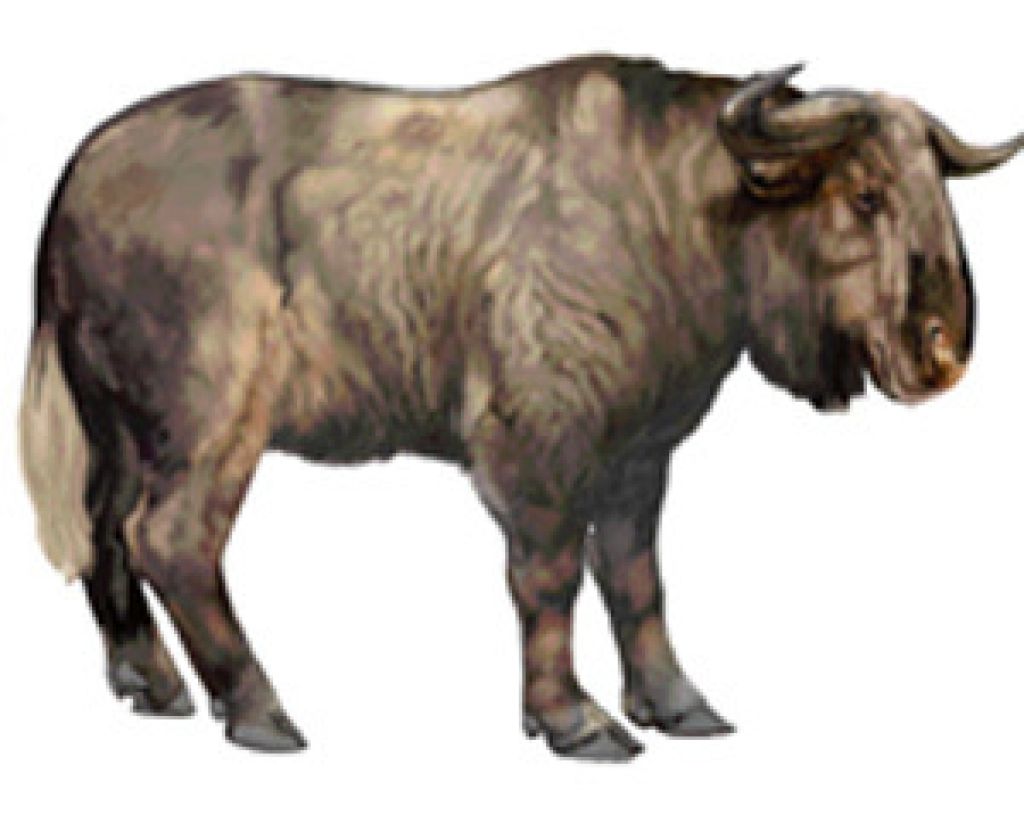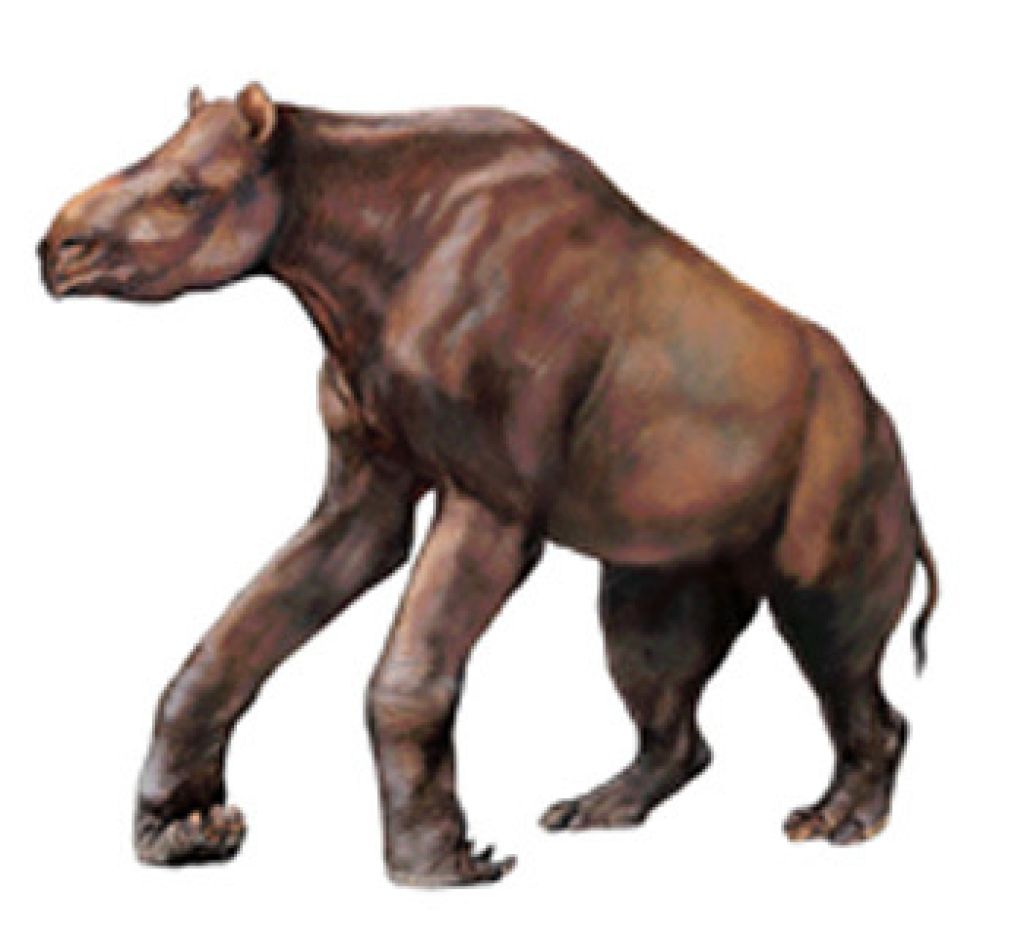What Is The Study Of Extinct Animals
Although Sterkfontein is all-time known for the hundreds of fossils of early hominids discovered hither, information technology has also yielded thousands of animal bones representing a cracking multifariousness of species, which tell united states nigh the environment and climate change.
The animals of past ages at Sterkfontein included the at present-extinct Dinofelis and Megantereon sabre-molar cats; the long-legged hyena, Chasmaporthetes; Parapapio, Papio and Cercopithecoides monkeys; a heavy, cow-like animal called a makapania; a tiny, three-toed horse, Hipparion lybicum; a behemothic hyrax or "dassie"; and a huge chalicothere, a knuckle-walking animal related to a horse.

A model of a sabre-tooth cat is part of the Sterkfontein exhibit
Palaeontologists take different methods of dating available to them, depending on the environment in which the fossils are establish. At the Sterkfontein Caves, one way of determining the historic period of the fossils is by using radio-isotope dating of the cavern deposits. Some isotopes found in these deposits are unstable and decay over fourth dimension to class "girl" isotopes at a known rate. By checking the amount of disuse of an isotope, geophysicists can work backwards and determine how quondam the eolith is – and thus the historic period of the fossil.
Once a few species have been classified and placed in a timeframe, experts tin start to examine trends in evolution.
For instance, from fossilised remains of Australopithecus and Man at Sterkfontein and other sites in Eastward and Southern Africa, we tin can run into how early hominids, having adult bipedalism (the power to walk permanently on two feet), adjusted to life beyond their original forest surround. The study of teeth and facial musculature, together with isotope analysis of bone, provides information on the nutrition of Australopithecus and Paranthropus hominids.
From animal and plant fossils, nosotros can besides determine ancient environments and climatic conditions. Traces of certain plants and small-scale mammals are among the primal indicators of climate.
Pliocene to Pleistocene
The surroundings in the Cradle of Humankind was once far lusher and more tropical than information technology is today. Only under 2-million years ago, this landscape began to modify, opening up into the grassland it is today.

'Little Human foot', Australopithecus prometheus is one of the most famous fossils found at Sterkfontein
Nosotros know of these animals from fossils of their basic preserved in the Cradle of Humankind.
The written report of what happens to organisms after they dice, are buried and fossilised is known as taphonomy. Analysis of the condition of bones, including signs of breakage and molar marks, reveals information on how the bones ended up in the caves.
There were iv principal means in which the bones of the animals which somewhen became fossilised came to be in the caves: through the activities of porcupines, hyenas and big cats, or through falling in.
Palaeontologists look for clues on the bones to uncover their mysteries. Porcupines champ bones into sharp points, for instance, leaving feature chisel marks around the edges. Hyenas have jaws stiff enough to crunch basic, breaking them through the centre, then palaeontologists wait for tell-tale chips and flakes from the impact of their teeth on a bone. Occasionally, hyenas volition also get out toothmarks on a bone.
Large cats such as leopards, on the other mitt, don't have teeth powerful enough to crunch bones, and volition leave ragged toothmarks at the end of bones.
Ane of the nigh exceptional finds at Sterkfontein, fabricated by University of the Witwatersrand palaeoanthropologist Professor Ron Clarke and his team, was the fossilised skeleton of the australopithecine "Little Foot", which had probably fallen down a shaft live between 4-million and 3-million years ago, never to return to the surface.
Studying fossils
Palaeontologists examine the characteristics of a fossil to make up one's mind what animal or establish it belonged to and its place in the evolutionary framework.

Mrs Ples was found at Sterkfontein
3-million years ago, in a geological epoch known every bit the Pliocene, environmental atmospheric condition at Sterkfontein were warmer and wetter than today, and the landscape was a mosaic of forest, woodland and grassland. From fossils, we know the vegetation included liana vines of the kind now found only in tropical forests in Key and Due west Africa. Fossils of large, wood-dwelling house monkeys are also relatively common in the older Member 2 (well-nigh 4.2-one thousand thousand to 3.3-million years quondam) and Member 3 (virtually 3.iii-million to 2.5-million years erstwhile) at Sterkfontein, and are bear witness of this lusher environment.
Fossils of browsing antelopes such as Hippotragus (similar to a modern-twenty-four hour period sable antelope) indicate continuing woodland atmospheric condition in Member 4 (near 2.5-one thousand thousand to two.1-million years old), and afterwards that a marked shift towards open grassland is documented by the fossils of savannah species such as zebras, ostriches and bound hares, as well as many thousands of fossils of grazing antelopes, including wildebeest and hartebeest, that occur in Member v (about 1.nine-million to 1.five-million years old).
The study of carbon isotopes reflecting diet, and hence surroundings, confirms this scenario. The data suggest that in that location was a adequately wooded environment until about ii-million years agone, followed by a marked shift to open environments effectually 1.8-million years ago, corresponding with the onset of the Pleistocene.
Many human being evolutionary changes occurred during the Pleistocene, an epoch characterised past changes in climate, swinging between glacial weather (colder, drier, with lower sea-levels) and relatively brief interglacial episodes (warmer, wetter, higher sea-levels).
Fossils in Sterkfontein

Millions of years ago, the Cradle of Humankind's landscape was lush and tropical
Fossils are the remains or traces of ancient plants and animals, preserved in rocks such as cemented cavern deposits called breccia. Fossils are formed when minerals, including calcium carbonate, envelope or supervene upon bones and other organic matter, hardening or encasing them within rock that remains unchanged for millions of years. The geology of the caves at Sterkfontein has provided an platonic environment for the formation and preservation of fossils.
Some areas of the Cradle of Humankind are so rich in fossils that they have go "time capsules" that provide us with unique relics of specific time periods, and then glimpses into the world in which humanity was built-in.
A wide cantankerous-section of creature and found fossils spanning millions of years is preserved at Sterkfontein.
The fossils at Sterkfontein were formed when skeletal remains were covered by soil washed into the caves. Calcium carbonate dissolved in h2o dripping into the caves suffused through the bones and other organic material, binding them in a matrix of stone and finer sediment called breccia.
At Sterkfontein, there are half dozen Members (sedimentary units or layers) of stone containing fossils dating to between nigh four.2-million years and 100,000 years sometime, giving us an extraordinary history of fauna and hominid development. People who study fossils – palaeontologists and palaeoanthropologists – delve systematically through these rich deposits in search of new information about the past.
The people who study the past
Palaeontologists: Study animal and plant fossils
Palaeoanthropologists: Study prehistoric civilisation and the beefcake of hominids (human being ancestors) and the surround in which they lived
Archaeologists: Study material cultural remains of ancient peoples, such as rock tools
Geologists and geophysicists: Report the Earth and rocks and are involved in dating fossils
Millions of years ago, the Cradle of Humankind's landscape was lush and tropical
Extinct animals
Extinct Parapapio monkey
Two species (Parapapio broomi and Parapapio jonesi) of this extinct genus of large monkey accept been found Sterkfontein, dating to betwixt almost 3.five-million and 2-million years ago. Parapapios are associated with woods environments and thrived when the local environment was warmer and wetter than today.
They lived at the same time and in the same areas equally early baboons of the genus Papio. Other Parapapio species accept been constitute at Taung and Makapansgat, also equally in Republic of angola and East Africa.
Extinct colobus monkey (Cercopithecoides)
In that location are near 30 species of modern-day colobus monkeys, which live in forest and woodland in tropical Africa and in southern and eastern asia. They have specialised teeth and complex stomachs for chewing and digesting leaves. The biggest colobus is the large-nosed proboscis monkey, which weighs over xx kg (44 lb), and lives in Borneo. In the distant past at that place were many other species of colobus monkeys, including the genus Cercopithecoides, which occurred in Europe and Southward Africa.

The modernistic-day Republic of angola colobus monkey
Cercopithecoides monkeys were virtually twice equally big as today'south vervet monkeys. Their fossils have been found in the Cradle of Humankind, at Sterkfontein, Bolts Farm, Kromdraai, Swartkrans, Haasgat and Makapans Valley, covering the period from the late Pliocene to the middle Pleistocene, from nigh three-million years agone until 1.v-million years ago. Cercopithecoides likewise occurred in East Africa. Similar modern colobus monkeys and monkeys of other species, Cercopithecoides probably lived in family groups. Considering of their large size, they possibly spent time on the ground too as in copse.
Extinct makapania

Artist's impression of a makapania
This extinct ox-like animal, which lived between 3-million and 2-million years ago, is related to the nowadays-day musk ox of the Chill and the takin of the woodlands of the Himalayan foothills. All of these belong to a grouping known equally the Ovibovini.
The Makapania broomi blazon-specimen was found at Makapansgat, another part of the Cradle of Humankind World Heritage Site, about 300 km (185 mi) from Sterkfontein, near Mokopane in Limpopo Province. Makapania fossils have likewise been discovered at Sterkfontein, Swartkrans, Gladysvale and Motsetse in the Cradle of Humankind.
Extinct hunting hyena (Chasmaporthetes)
These were like to a mod spotted hyena in size, but had longer legs which maybe fabricated them better hunters. They lived in the Cradle of Humankind betwixt about three-million and 1-million years ago during the time of Australopithecus and Paranthropus, and Homo, and are known to have existed in E Africa and Eurasia more than 4-million years ago. They spread into America earlier 3.5-million years agone.
Extinct chalicothere
These strange, knuckle-walking creatures had equus caballus-like heads and steeply sloping backs. Giants at more than 2 metres (6'5") tall, chalicotheres ate only soft vegetation such as new shoots. The huge claws on their front anxiety may have been for pulling down vegetation as they fed, similar to the way gorillas or pandas practise today.
Chalicotheres lived between 45-million and virtually 1.8-million years ago. Their closest living relatives are horses, tapirs and rhinos. Calicothere teeth and limb bones accept been constitute in the Makapans Valley, and a toe bone has been found at Sterkfontein.

Artist's impression of a chalicothere
Extinct sabre-tooth true cat (Dinofelis)
Sabre-toothed cats are and then-called because they take long, bract-like, upper canine teeth. While impressive, Dinofelis' upper canines were non as long as those of Megantereon and Homotherium saber-tooth cats, which lived at the same time in the Cradle of Humankind.
Dinofelis was about the size of a jaguar and had relatively short, but powerful front end legs. These big cats are associated with a forested environment and had become extinct by near 1-million years ago.
Source: https://www.maropeng.co.za/content/page/studying-fossils-and-extinct-animals
Posted by: adamsboyeto.blogspot.com

0 Response to "What Is The Study Of Extinct Animals"
Post a Comment